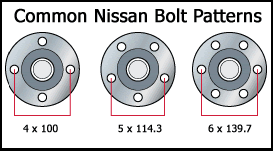
We’ll be starting a new segment in the Math section, this time focusing on the wheels and tires. There won’t be any real math here; I’ll just be explaining how to identify wheels and tires. The technical and technological stuff behind the creation of each wheel and tire will be for a different section.
When looking at any wheel, its measurements are presented in a certain way. Here’s an example:
[17x9 et30 5×100] Now what do these numbers mean? I”ll explain:
The first number (indicated in red) [17x9 et30 5×100] is the Wheel Diameter(inches). This is how “big” the wheel is when looking at the face of the wheel (in inches), or from the side of the vehicle. We don’t measure in radius’, only diameters. When people talk about “22s”, or “30s” on their Escalades, its the wheel diameter theyre talking about upgrading. Remember, this is only the wheel width, and does not take into account the tires. Why do people want bigger wheels? Well most of the time is because the look “cooler”. Performance wise, when we upgrade the size of our wheel, usually we downgrade the sidewall of our tires. Here is a picture:
This downgrading of our tire sidewall gives the car less of the sidewall to “cushion” or “flex”. What does that mean? Well, imagine our tires as a cushion between the road and our car. When we hit a rock on the road, the air in the tire and the tire itself takes some of blow and cushions it. Now imagine driving on the road with no tires. You’d feel every bump and pothole wouldn’t you? When applying this to the racing world, less cushioning means faster action and reaction between the road and the car. Tire sidewall flex creates a sort of cushion between the driver input and the road, dampening both our feel of the road and the time it takes for our actions to reach the road. One way to relate it to the real world would be to imagine yourself running around with big balloons under your shoes. When you turn, you have to wait for the balloon to compress and settle before you can press down with your feet and launch yourself in another direction. This is the same for the tire. If we have less “cushioning”, the actions can be more direct between the driver and the road.
The next number [17x9 et30 5×100] is the Wheel Width(inches). This is how “wide” the wheels are, also in inches. Usually, the wider the wheel, the more horizontal grip the car has when turning. We usually want the widest wheels we can fit under our car to give us the best grip. Another way to relate it to the real world would be to imagine yourself riding a bicycle. Imagine the bicycle wheels to be really thing. Now think about turning at a high speed. You’d probably end up sliding due to the wheels not having enough grip. Now imagine driving a steamroller. I bet you would turn alot faster with wheels of that width since we have alot more lateral grip to keep us from flipping over.
The “et30” in [17x9 et30 5×100] represents the Wheel Offset(millimeters). Now we’re switching to metric. The wheel offset is a bit harder to explain. Looking at the picture here:
We can see that with a “0 (zero)” offset, the point at which the wheel is bolted onto the wheel hub “splits” the wheel width in 2. The “outside” of the wheel is as wide as the “inside” of the wheel here. So a wheel width of 9 inches would be connected to the wheel hub 4.5 inches “into” the wheel. With a positive offset though, the wheel is connected to the hub closer to the outside of the wheel. So a wheel with a “30” offset would be connected to the wheel hub 4.5 inches plus 30 millimeters from the inside of the wheel. If we compare the two, the positive offset would look like the wheels are going deeper into the car if we’re looking from the side of the car. And obviously then, a negative offset would then “push” the wheel out of the car, looking like the wheels are coming further out of the car.
And the last set of numbers “5×100” in [17x9 et30 5×100] represents the Bolt Pattern of the wheel. The 5 stands for 5 bolts on for the wheel/wheel hub, and 100 millimeters for the length of the bolt. Here’s another diagram:
And that pretty much explains everything. The next article will be dedicated to the tires. Stay tuned.



